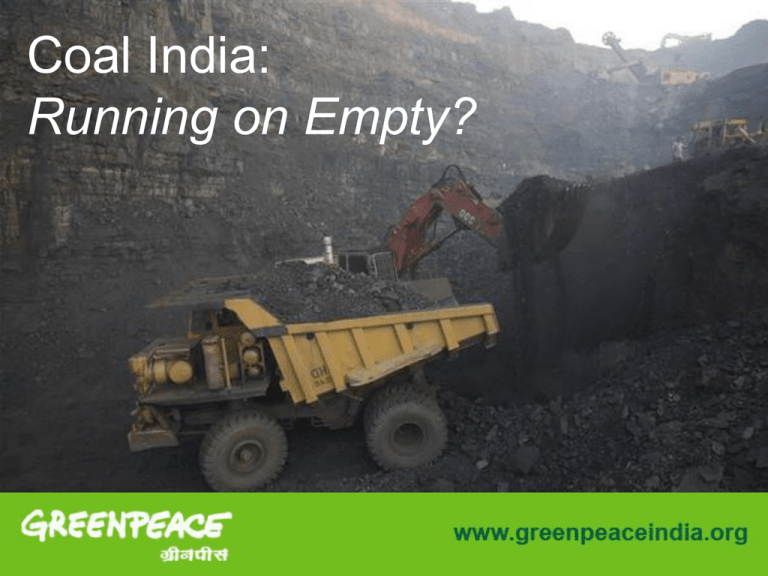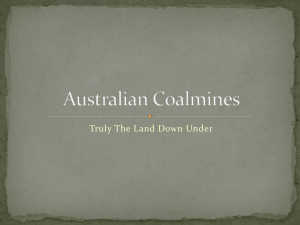Coal India: Running on Empty, by Ashish Fernandes
advertisement

Coal India: Running on Empty? Key Findings • In its 2010 Red Herring prospectus, CIL claimed 64 bt of total coal resource, of which 21.7 was considered proved and extractable • CIL used the 1956 Indian Standard Procedure (ISP) system as its basis. • In 2011 – CMPDI completed the United Nations Framework Classification exercise – placed extractable reserves at 18.2 bt, 3.5 bt less than earlier stated • This amounts to a reduction of 16% in its extractable reserve, approximately $4.25 billion in company value • Rest of CIL’s current “resource” (62 bt) is considered not currently extractable Key Findings • At targetted production growth rates (8%), CIL’s reserves could be exhausted in 17 years. • Extractable reserves could be further reduced as CMPDI has not done feasibility studies for most of this 18.2 bt. Example: area under forest, water bodies, farmland etc. not assessed • Reserves could in fact be exhausted in less than 17 years Reserve Classification Systems • India has historically used India’s ISP system to arrive at extractable reserve figures. According to 2012 CAG report, ISP is confined to volume/tonnage and geological parameters, ignores feasibility and economic viability. • The UNFC system was devised by participating countries, including India, in order to move towards a uniform system of mineral classification suited for international comparison. India decided to adopt UNFC system in 2001. • The two classification systems, ISP and UNFC, differ on the number and range of criteria they use to arrive at the extractable reserve. UNFC System • Govt of India decided to switch to UNFC in 2001. Coal India & Coal Ministry did not act. • Since then, the need to accelerate the switch to the UNFC system has been stressed by: - Expert Committee on Roadmap for Coal Sector Reforms (2007) - The Energy Resource Institute, TERI (2011) - The Indian Chamber of Commerce, via a PriceWaterhouse Coopers report in 2012 on the challenges facing the Indian coal sector and the future outlook. • Because the UNFC system considers three criteria, economic viability (E), field project status and feasibility (F), and geological knowledge (G), it is considered a more accurate measure of extractable reserves than the ISP system. • Each criteria has a number ranging from 1 to 3 with 1 being the most valuable. • A coal reserve of Class 1.1.1 is considered to be of prime interest to investors and is ‘proved mineral reserve’. • The total coal that exists is the resource. Only some of this is extractable. • CIL’s 2010 extractable reserve figure of 21.7 BT based on 1956 India Standard Procedure (ISP) system. • UNFC assessment done by CMPDIL showed 18.2 BT in 2011. Investor issues • Government took decision to shift to UNFC from ISP in 2001. • CIL/CMPDI documents show that the UNFC exercise was underway since 2005 or earlier. • But no mention made of UNFC assessment in 2010 IPO prospectus. • UNFC figures submitted by CMPDI in 2011. • Approved by CIL board and uploaded to CMPDI site in 2012. • But no announcement or notice to stock exchanges, regulator or investors. CIL continued to use old figures. • Clear case of non-disclosure. Complaint to regulator • CIL now proposing to sell more shares on the market. Can investors trust the company? CIL reaction • After the Sept 23 release of the GP/IEEFA reserves report, CIL claimed the report was “rubbish” • Claimed they add 2 bn tonnes of reserves every year and do not disclose this to exchanges either • However, 17 days later, on Oct 10, CIL investor presentation used, for the first time, the UNFC figure of 18.2 bn tonnes. ISP figure dropped. • Ex-CIL geologists confirm that the company management wrongly considers its “resources” and its “reserves” as synonyms, creating a false sense of security. Implications • At targeted production growth rate of 8% CIL’s extractable reserves will be exhausted in 17 years. • Even with a lower growth rate of 5%, CIL would exhaust all its extractable reserves by 2034. This growth rate is too low to meet projected demand. • This means power plants recently built /under construction/proposed will face coal supply issues through all or most of their lifetime (~ 25 years). • Plans to add at least 100GW more coal power by 2017 • Very real risk of stranded or unprofitable investments • CIL already says it is unable (and unwilling) to meet demand. Temporary blip or permanent decline? Coal supply a serious problem • CIL forced by Govt of India (Presidential directive) to enter into supply contracts. • Insufficient supply to meet demand – can meet only 65% of supply to plants built after 2009. • Has refused to add additional plants (i.e import dependent) to its list of obligations Implications • Pressure to import coal will rise – price burden will have to be borne by consumers or producers or distributors. Threat to the economy. Example: Mundra and Krishnapatnam projects • Increased dependence on imports - energy security threat • India will be hostage to the international coal price • Impacts on the Current Account Deficit, forex reserves and value of the Rupee • Increased desperation to tap any coal reserve, irrespective of social and environmental price – intensified conflict • Privatisation or break up of CIL will not help as basic problem is paucity of extractable reserve and uncertainty around figures Can CIL increase its reserves? PRACTICAL CHALLENGES: • Low exploration rates CMPDI’s exploration rates are just 33% of their target. 5,00,000 million meters as against a target of 15,00,000 million meters of drilling. 70% of India’s proven reserves have been allotted to CIL. CMPDIL has not conducted UNFC assessments outside of CIL’s blocks. Secretary, Min of Coal: “We don’t have too many explored blocks on offer.” ---- May 28, 2013. Can CIL increase its reserves? PRACTICAL CHALLENGES: • Shift to deep mining difficult 90% of CIL coal comes from open pit mines, less than 150 m. deep. Most shallow seams already being exploited. Most remaining coal lies deeper, below 150 m. CIL has created almost no new deep mining capacity in the last decade. Shift to underground mining could make consent and clearance easier, but will raise costs, reduce output. UG mines only able to extract 40-70% of a deposit. “Unless CIL shifts to underground mining, output will stagnate by end of this decade” DC Panigrahi, Indian School of Mines, 2012 Conclusions • High degree of uncertainty on actual extractable reserves. Could be even lower than 18.2 BT. • Reserve uncertainty a serious risk to Coal India investors and investors in the coal/thermal power sector. • Urgent need for an independent assessment of Coal India’s reserves, as stressed by numerous government committees, expert panels and think tanks for the last 7 years. • Coal shortage will be a chronic, not temporary issue, as long as power plants continue to be built. • Imports cannot bridge gap, coal power plant capacity addition unattainable • Continued coal dependence - risk to energy security / economy Questions to Coal India • When and how will CIL communicate the reduced estimate of its reserves to investors and the exchanges? • Will CIL explain why the UNFC figure differs so substantially from its earlier figures? • Was CIL aware of the UNFC figures at the time of its 2010 IPO? If so, why did it conceal them from the market? • What impact will the reduced reserves have on the company’s share price, and production targets going forward? Questions to Coal India • Is CIL’s consistent under production due to faulty calculations of its reserves? • How accurate is this UNFC assessment, given that it has not taken into account issues like forest cover, water bodies, farm land? What is the scope for a further reduction in the extractable reserve? • When will CIL commission an independent assessment of its extractable coal reserves?







